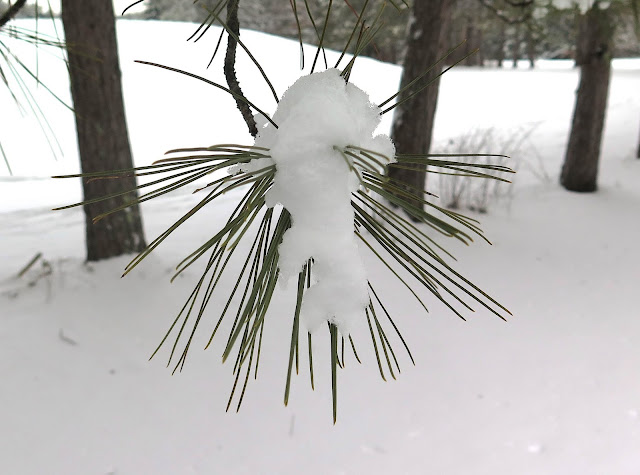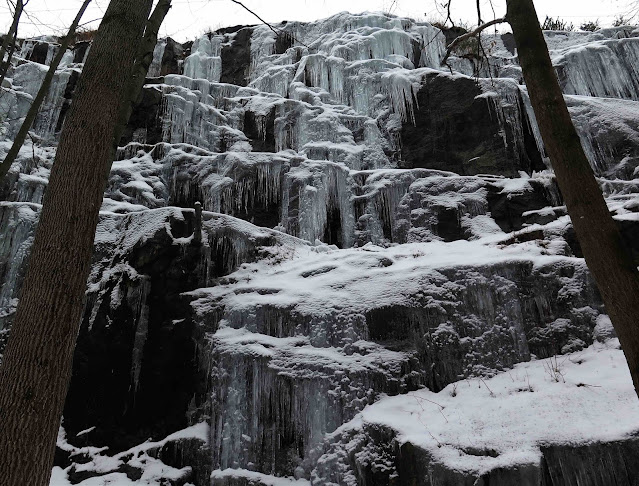Recent upheavals -- both personal and political -- have distracted me from my annual New Year's task: recording here in my blog all new plant finds from the year just past. In the broader scheme of things, I realize, "Who cares?" But over the now 12 years I've been keeping this blog, it has grown to be a rather comprehensive searchable record of regional flora, and I've come to depend on it to remind me not only of what plants I've found, but also where and when. So, just for the record, here goes:
Prevancher's Fleabane (Erigeron philadelphicum var. prevancheri)
Yeah, I know, it looks like just another no'count waste-place weed, like our other fleabanes, natives though they may be. But this one's pretty special. Prevancher's Fleabane has only recently been defined as a distinct variety of fleabane, and it's now recognized as an Endangered species (S1) in New York State, where it has been found in very few places. I happened upon it in mid-September along the exposed shale banks of the Hoosic River in Rensselaer County, exactly the kind of habitat that Prevancher's Fleabane is known to prefer. The short stature of the flower stalk was my first clue (our other fleabanes are leggier), but the persistent basal leaves this late in the year and dearth of stem leaves were the clinchers. I am happy to report I found many more plants than this blooming cluster: over 200 of the leafy rosettes sprouting out of a steep shale bank in the same area.
Winged Monkey Flower (Mimulus alatus)
Okay, I personally did not find this unusual Monkey Flower, nor did I first see it in 2020. No, my friend Sue Pierce first spotted its non-blooming stalks back in the fall of 2019 while exploring a creek bed at the Saratoga Battlefield with our group of botanical buddies, The Thursday Naturalists. After noting the long winged leaf stems and the short flower stalks (just the opposite of those of the more common Monkey Flower [M. ringens]), the consensus then was that this must be the Winged Monkey Flower. When Sue and I returned to the site in mid-August of 2020 to seek it in bloom, we found abundant numbers of these pretty pale-purple flowers. There were so many plants (well over a hundred) that Sue felt free to collect a specimen to submit to the New York Natural Heritage Program, in order that this Rare (S3) plant could be vouchered as present in Saratoga County. (She did have permission to do so from the NYNHP's chief botanist.)
Here's another photo, showing the face of the Winged Monkey Flower. The photo above shows the long leaf stalks and short flower stalks that distinguish this species.
* * *
The two rare plants named above were the only native species that were new to me this past year. The next two plants are both non-native, both of them introduced species originating in Asia and now gaining a foothold in the United States. It's fair to say I wasn't particularly happy to have found them, since both plants have the potential to become invasive.
Far-eastern Smartweed (
Persicaria extremiorientalis)

Whoa! Who fed some Ladies' Thumb steroids?! That was my first thought when I found these gigantic smartweeds at the edge of a thoroughly-disturbed-soil vacant lot on the Skidmore College campus in Saratoga Springs. They stood on stems up to my eyeballs and with flower clusters a good eight or ten inches long, and they DID look almost exactly like the much more diminutive smartweed called Ladies' Thumb (long the bane of over-tidy gardeners, everywhere). They even had the darkish "thumbprint" on many of the huge leaves. Except the plants were humongous. I later found out that this was another non-native species of Persicaria, related to Ladies' Thumb but only relatively recently established in northeastern North America. The vernacular name, Far-eastern Smartweed, is a direct translation of the scientific name, Persicaria extremiorientalis, indicating the Asian origin. The New York Flora Association's Plant Atlas shows this species as documented for only 5 counties in the state, so far, all of them much farther south than Saratoga County. Uh oh! Looks like this plant is heading north.
Vietnamese Balm, AKA Crested Late-Summer Mint (Elsholtzia ciliata)

I was with my friend Ruth Brooks when we saw this unknown flowering plant on the shore of the Hoosic River in Rensselaer County in mid-September. Well, it sure looked like a Mint Family plant, with its square stem, opposite fragrant leaves, and small purple flowers. But between the two of us, we know all the mints we were likely to find around here, and this wasn't one of them. Luckily, Ruth is a heck of a lot more tech-savvy than I am, with a cellphone loaded with plant-ID apps, so it took but a moment -- after she loaded a photo and pushed a few keys -- to discover that this was another Asian import, called Vietnamese Balm (and yes, a Mint Family plant). I later learned that local folks of Asian descent often grow this plant for both culinary and medicinal purposes, so it's not really so surprising that it's now making its way from kitchen gardens to the banks of a local river. The New York Flora Association's Plant Atlas shows it rather widely distributed across New York State, although not yet necessarily abundant. Not a happy find, however. According to Wikipedia, Elsholtzia ciliata has been classified as a "noxious weed" in 46 states.
* * *
The next two plants are ones I thought I knew well. But in the case of the aster, I failed to notice a pertinent detail, and I had the name wrong. In the case of the Spiranthes species, its name has been changed from one I've known, correctly, for many years. So, not new plant finds, but definitely ones I now know new names for.
Pringle's Aster (Symphyotrichum pilosum var. pringlei)

Peeking out from amid other plants that lined a sandy path at the Woods Hollow Nature Preserve near Ballston Spa were these starry-white asters. Their relatively large size, open habit of growth, and slender, pointed bracts suggested Frostweed Aster (Symphyotrichum pilosum) to me, except for one thing. The stems were not as hairy as most of my guidebooks described for this species. But it didn't take long, once I posted this photo on Facebook along with my query about it, to learn that this is, indeed, the aster Symphyotrichum pilosum, but a less hairy variety called pringlei, which goes by the common name of Pringle's Aster. A new flower for me! Except that I've probably seen it many times, just calling it by the wrong name. According to NYFA's Plant Atlas, the Pringle's Aster, "compared to the typical variety of S. pilosum, . . . grows in drier sites with less herbaceous competition, and more often is in more native type habitats."
Sphinx [formerly Nodding] Ladies' Tresses (
Spiranthes incurva)

Sigh! I thought I had all our local species of Ladies' Tresses (Spiranthes spp.) down flat, according to when they bloomed: S. lucida in June, S. romanzoffiana in early August, S. cernua in early September, and S. ochroleuca as late as October. They're kind of hard to tell apart, otherwise. Well, I don't know about the other species, but the species we used to know as Spiranthes cernua (Nodding Ladies' Tresses) has now been assigned to a number of other species in addition to S. cernua. Turns out, we don't really have S. cernua in Saratoga County, and the orchid we used to know by that name is really Spiranthes incurva (Sphinx Ladies' Tresses). At any rate, the Ladies' Tresses pictured here, which I used to call S. cernua, I must now learn to call S. incurva. It still looks and smells the same as it always did, with the sharp curve of its florets' lower lips and its sweet fragrance. It is quite a common species of this orchid in Saratoga County, and I found this one blooming at Woods Hollow Nature Preserve in early September.
* * *
Cucumber Magnolia (Magnolia acuminata)
This last find for the year was a small tree with big oval dangling leaves that had turned yellow in the late-October woods near Schuylerville. It was obviously not a sapling of the surrounding oaks and hickories and hornbeams, but what the heck was it? Neither my pal Sue nor I could even hazard a guess. A close look at the end of a twig revealed a new bud that was covered with a pale pubescence, and I could also detect a stipule scar that completely encircled the twig. After posting the photo above on a Facebook page dedicated to the flora of New York and asking for ID suggestions, these two features -- the pubescent bud and the encircling scar -- were exactly the features that convinced several expert responders that this was a tree in the Magnolia Family. A Cucumber Magnolia (
Magnolia acuminata), to be exact, a tree that is native to our northeastern region, including counties adjacent to Saratoga County (although not yet recorded from here). I never even knew that we had any native magnolias around here! Facebook can be an amazing source of information!
We could not find any signs that would indicate these trees had bloomed or borne fruit. Were the ones we found (and there were many) too young as yet? Were there older and larger magnolia trees in this same woods that had already dropped their leaves and so we couldn't identify them? For sure, Sue and I will return to this woods next spring, hoping to find Cucumber Magnolias in bloom. And if we do, I'll come back here and post a photo of the flower. Unless I save it to post next January in my next year's blog post, "New Plants From 2021".

















































